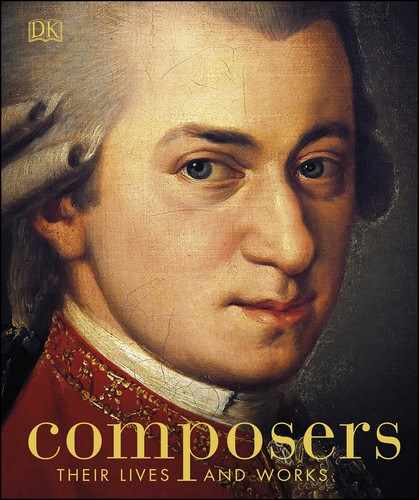Giovanni da Palestrina
c. 1525–1594, ITALIAN
Palestrina is best known for his spiritually uplifting vocal music for church services. He achieved a serene purity of expression through his mastery of the complex interweaving of voices.

GIOVANNI DA PALESTRINA
The Italian Renaissance composer is shown here holding the score of his famous Mass Missa Papae Marcelli (1562). According to Palestrina, “Music should give a zest to divine worship … delighting in voices blending in harmony.”
IN CONTEXT
Palestrina and the Counter-Reformation
In the 16th century, provoked by the Protestant Reformation, the Catholic Church embarked on a Counter-Reformation to remedy lax practices and reinvigorate the faith. In the 1560s, Catholic divines meeting at the Council of Trent discussed banning music from church services, arguing that it distracted worshippers with sensual pleasure. There is a legend that a performance of Palestrina’s Missa Papae Marcelli so moved the church dignitaries that they changed their minds. Although the legend itself is not true, Palestrina’s music did in the long run satisfy the Church that chaste spiritual music could indeed reinforce Catholic faith.
Born Giovanni Pierluigi around 1525, the composer became known as Palestrina after the name of the town of his birth, just outside Rome. As a child, he sang in the choir at Rome’s prestigious basilica of Santa Maria Maggiore. By the age of 20, he had been appointed director of music at Palestrina cathedral, and six or so years later, he was invited by Pope Julius III to head the choir at St. Peter’s Basilica, which involved writing sacred music and directing its performance. Palestrina’s first book of Masses was published in 1554.

POPE JULIUS III
Julius III (depicted here by the sculptor Fulvio Signorini) spotted Palestrina’s talent when the young composer was director of music at Palestrina cathedral.
A change of fortune
Julius III was not concerned that Palestrina was married (the holder of the post was supposed to be celibate) or that his religious works were interspersed with secular madrigals. However, after Julius’s death in 1555 and the brief reign of Pope Marcellus II—to whom Palestrina dedicated his most famous Mass, Missa Papae Marcelli—the more austere Paul IV was installed in the Vatican. The new pope dismissed Palestrina.
Nevertheless, the composer’s talent and reputation ensured him work at other Roman churches. By the time he was reinstated as papal choirmaster in 1571, he had adapted his style to the demands of the Counter-Reformation (see box), describing his new works as “music written … in accordance with the views of the most serious and religious-minded persons in high places.”
In the 1570s, plague raged in Rome. Palestrina suffered the deaths of his wife and two of his three sons. In 1581, however, he married a second time, the widow of a Roman fur trader, and took over running her former husband’s business, which he handled very profitably. Alongside this commercial activity he continued to write a stream of Masses and other sacred music, including settings of the Song of Solomon published in 1584 and the Stabat Mater for eight voices, dating from around 1590. By the time of his death in 1594, his total output amounted to 105 Masses, more than 300 motets, and hundreds of other works, both religious and secular.

SCORE OF MAGNIFICAT
This illuminated 16th-century manuscript is the first double page of Palestrina’s score of one of his settings for the Magnificat, or the hymn of praise by Mary, as found in the Bible.
Music from Heaven
Palestrina was famous in his lifetime and his reputation remained high through the succeeding centuries. His works were widely studied as perfect technical examples of polyphony and were admired by composers from Bach to Mendelssohn, who claimed that Palestrina’s music sounded “as if it came direct from Heaven.”
